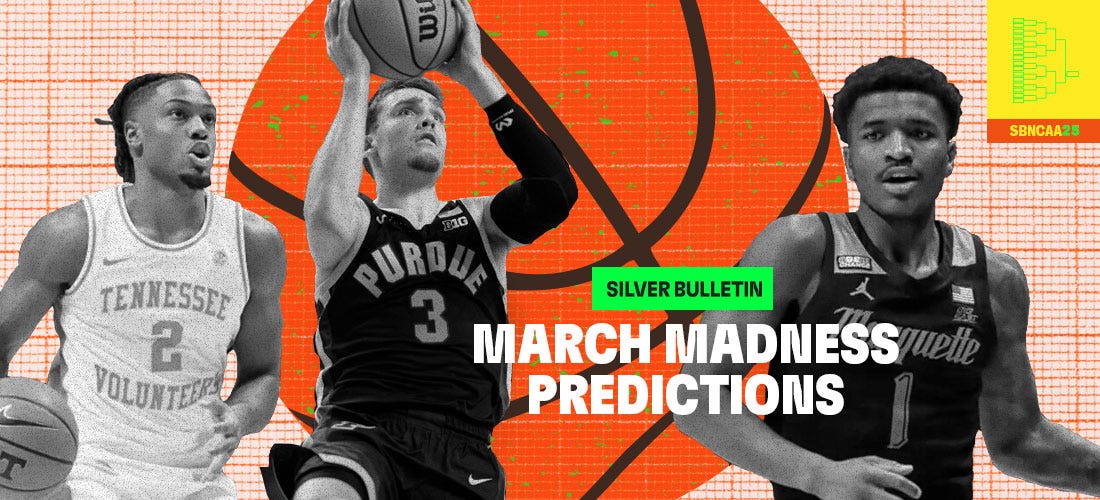🕒 Last updated: 10:20 a.m., Wednesday, April 9
Congrats to the Florida Gators for winning the national title after a clutch comeback against Houston.
We’ll work to restore this page so it reflects our original pre-tournament projections while also providing spreadsheets with the interim projections we made throughout the tournament — though give us a moment with all the other news in the world this week.
Our season-ending men’s SBCB ratings can be found here.
We’ve been hard at work on our college basketball forecasts this year. We’ve recalibrated them based on analyzing more than 250,000 historical college basketball games. We now have our own fully-fledged rating system — SBCB — though our ratings are combined with other systems for purposes of our tournament forecasts. And there are some new wrinkles this year, too, like a better formula to account for injuries1 — though if you’re reading this from Durham, North Carolina, you’ll be glad to know that it looks like Cooper Flagg will be OK.
Still, March Madness projections are an annual tradition in these parts. We’ve run tourney forecasts through literally every iteration of Silver Bulletin/FiveThirtyEight dating back to 2011. Some of the code1 in the model goes back even earlier than that from when I was trying to win my friend’s unnecessarily complicated office pool as a junior associate at KPMG back in 2002 or 2003. The tournament was also key to our launch strategy at the Disney-fied version of FiveThirtyEight in 2014. And if I’m being honest, it was an inflection point for this newsletter. I was on the fence about running the 2024 version, but I figured it was worth a few hours of work on an idle Sunday. Instead, it took until 3 in the morning. But our paid subscription count basically tripled overnight to the point where I thought it was some sort of glitch. That was all the proof of concept we needed to reboot the election forecast and other things.
How this works
We’ll update these numbers once per day (often in the morning) after tournament games are played. If you’re reading this by email, you’ll want to use the web version because we can’t magically change the text in your inbox.
These ratings give half the weight to our Bayesian SBCB ratings2 and half to a composite of other systems, namely:
The Massey ratings
And the NCAA tournament committee’s S-Curve rankings, i.e. how it seeds all tournament teams from 1 through 68.
They also account for injuries, travel distance, and — once the tournament is underway — how teams have performed so far in the tourney relative to the model’s expectations. (Getting “hot” in the tourney is a thing.) For more detail about how all of this works behind the scenes, see here.
Let’s cut to the chase: who’s the most likely winner?
Usually, there’s strong alignment between who we think the best teams are and who has the best odds. But this isn’t always the case. There can be discrepancies introduced based on how easy or difficult each team’s draw is, injuries, and the geographic location of each game — plus who’s managed to survive in the tournament so far.
What you’ll find on the rest of this page — and throughout the tourney
Projected odds for all rounds in all four regions; the South is free for all readers, while the other regions are a benefit for paying subscribers.
Forecasted win probabilities and margins of victory — which conveniently double as point spreads — for forthcoming games.
A spreadsheet version of these forecasts with additional precision.
Additional tables and spreadsheets comparing all rating systems we use on a common scale, plus current injury adjustments.
I’ll probably send an update or two out over the email list, but we won’t spam you; approximately 27 percent of Silver Bulletin subscribers are degenerate gamblers extremely interested in the tournament while others are not interested at all. For notifications of updates, please follow me on Twitter. Or perhaps better, Substack Notes. It won’t be an overnight transition — but I’m planning to gradually do more of my “microblogging” on Notes given the problems with the alternatives.
Also, we know from past experience that many people subscribe just for the tournament forecasts and then don’t stick around so long. We won’t take offense, and we appreciate your business either way. But we do think the annual subscription price is the better deal, and we plan to gradually reintroduce various sports and politics models over the course of the next year.
Here are our updated odds for the four regions:



